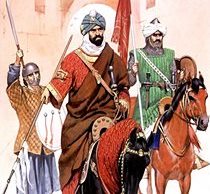
Battle of the Fields of Cato |
year: 548Spring 548 |
| Decisive victory of the Byzantines against Moorish tribes | ★ ★ ★ ★ ★ |
|
enemy: Berbers
|
location: Somewhere in central Tunisia in the plains bordering the desert in the region Mammes
|
accuracy:
●●●●●
|
|
battle type: Pitched battle |
war: Berber Tribes Rebellions |
modern country:
Tunisia |
| ▼ The Byzantines(emperor: Justinian I) | ▼ The Enemies | |
| Commander: | Ioannes Troglita | Carcasan & Antalas (Berber Kings) |
| Forces: | perhaps around 150,000 | |
| Losses: |
| Background story: |
| The Byzantine governor of Carthage Ioannes Troglita, after his defeat by the Moorish rebels in Marta the previous year, remained in Byzacena (central southeast Tunisia) at the fortress Laribus (or Alorbos) where he regrouped his forces and organized a new military operation against the Berbers. Troglita succeeded not only in reconciling his Berber allies Cutzinas and Isfidaias, but also in gaining the allegiance of King Iaudas and his tribe. The historian Corippus gives extraordinary numbers for the native contingents provided by each chief: 30,000 for Cutzinas, 100,000 for Isfidaias, and 12,000 under Iaudas’ brother. Whatever the real numbers, Troglita’s regular troops formed the lesser portion of the imperial army. Troglita now moved his army to confront the enemy but the Moors followed a well-tried Moorish tactic of withdrawing and drawing the Byzantines into the interior, forcing them to march in the desert, far from their supply bases and through a devastated country, thus exhausting and demoralizing them. |
The Battle: |
 Berber warriors The plan worked: encouraged by sacrifices to their gods and hoping to catch the imperial army unprepared, the Moors attacked the Byzantine camp on a Sunday. The battle hung long in the balance, with many dead on both sides, but eventually the Byzantines gained the upper hand. At this point, Carcasan rallied his forces and launched a fierce counterattack, but was killed by Troglita himself. Seeing their leader fall, the Moors broke and fled. It was a huge success for the Byzantines: seventeen of the Moors’ principal leaders were dead, the Tripolitanian tribes were decimated and withdrew to the desert, and Antalas and his followers submitted to Troglita. |
Noteworthy: |
| Ioannes Troglita’s exploits are the subject of the last Latin epic poem of Antiquity, the Iohannis, seu de Bellis Libycis (“Tale of John, or On the Libyan Wa”) of Flavius Cresconius Corippus, which is the main source on his life. |
Aftermath: |
| Byzacena, Numidia, and Tripolitania were finally secured, and a period of peace was inaugurated that lasted for the next fourteen years, until 562. |
|
|
